Planting Date Vs Yield Potential
By Louis Kuisle | May 31, 2022
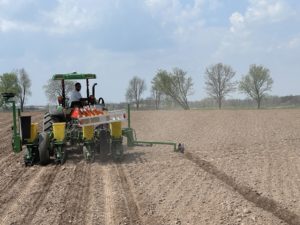 Throughout the Midwest, this spring has been mired with adverse weather conditions. As of Monday 5/23/22, progress reports in Iowa place the expected corn crop at 86% complete and soybeans at 69%. These figures are 3 days and 1 day behind the five-year average respectively. The same report for Minnesota puts corn at 60% planted and soybeans at 32%. These figures are about a week and half behind average. Wisconsin has made significant improvements nearing 70% corn and 40% soy, but like MN, the differences in weather patterns between portions of the state are significant. Much of West Central and Northwest MN is much farther behind average and this trend continues into North Dakota and Northern South Dakota. With North Dakota at 20% corn, 7% soybeans, 27% spring wheat, 17% Durum wheat planted, most crops are 40% or better behind average.
Throughout the Midwest, this spring has been mired with adverse weather conditions. As of Monday 5/23/22, progress reports in Iowa place the expected corn crop at 86% complete and soybeans at 69%. These figures are 3 days and 1 day behind the five-year average respectively. The same report for Minnesota puts corn at 60% planted and soybeans at 32%. These figures are about a week and half behind average. Wisconsin has made significant improvements nearing 70% corn and 40% soy, but like MN, the differences in weather patterns between portions of the state are significant. Much of West Central and Northwest MN is much farther behind average and this trend continues into North Dakota and Northern South Dakota. With North Dakota at 20% corn, 7% soybeans, 27% spring wheat, 17% Durum wheat planted, most crops are 40% or better behind average.
What is still realistic for grain corn as we approach June? With inflated commodity prices, input costs, and relative economic uncertainty on the horizon, deciding how far to push the planting envelope has never been more difficult so we will turn to the data…
Iowa
Optimum corn: April 15 to May 9
The graph indicates the significant drop off or “Slippery slope” as we enter June for central to northern
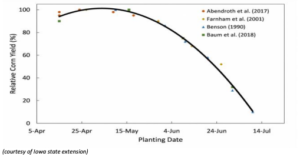
Minnesota
Optimum corn: April 25 to May 10 Graph across southern to central MN indicates the yield drop off does not happen as quickly as the data coming from Iowa. On average 5-10 days delayed.
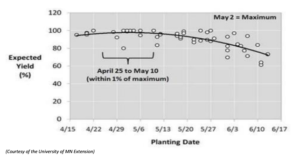
Wisconsin
Optimum corn Southern Wisconsin: April 20 to May 5th
Optimum corn Northern Wisconsin: April 30 to May 15th
Data from the University of Wisconsin highlights the same trend that the “Slippery Slope” of falling yield potential occurs throughout the corn belt. Higher latitudes only move that calendar date back incrementally to the shorter growing seasons
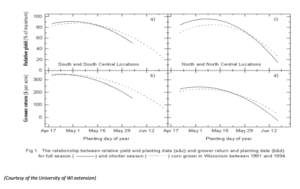
Corn Maturity Selection
Prevent plant is nothing that anyone wants to do. A marginal crop is usually a better option that PP, especially with high commodity markets. Late planed corn can be an unnerving proposition with extremely high drying fuel costs, but how far do you drop maturity? There is no doubt that yield will be decreased with dropping maturity. Many hybrids’ transitions from some version of flex ear to fixed or semi-fixed as the GDU’s to black layer are decreased. Calculating the needed GDU’s to black layer given the potential planting date is the single most important consideration when determining how far to decrease RM.
A hybrid will follow this chart on average where RM = maturity days * 25GDU
![]()
Current heat units can be calculated with a relatively simple formula following the rule that GDD are not accumulated above 86 degrees or below 50 degrees.
High temp(Min 50/Max 86) + Low temp (Min 50)/2 = GDD average
GDD Average – Corn low cutoff of 50 = GDD units.
Historical daily temps can be found at National Weather Service multiple years are also available to compare to temperatures in years past.
Other websites are available that can give a predictive model and save time from doing your own calculations. Useful to Usable is one of the better ones available.
Switching to Soybeans
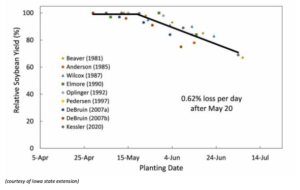
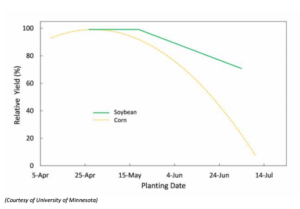
Soybeans are a very attractive crop choice as we push later into the spring. There is undoubtedly a decline to yield potential as the season progresses, but that abrupt drop off is more mitigated into linear decline. Soybeans, being more dependent on photoperiod and rainfall timing, can be a little more predicable choice.
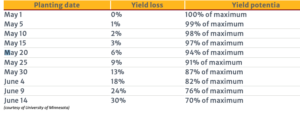
Possibly the greatest debate with soybean planting is what maturity and population. There are some studies that indicate full maturity soybeans have a greater yield potential, but also a bigger penalty when planting is delayed. Being that soybeans are heavily photoperiod depending, there needs to be consideration to the summer solstice. In 2022 the longest day of the summer is June 21.
Soybeans will regulate their reproductive cycle relative to the decreasing daylight hours past this period. Early maturity soybeans that are bred for latitudes with shorter summers and longer days can produce very well planted south of their traditional zone, but keeping these shorter days in mind, the population will need to be significantly increased.
For many growers who double crop soybeans after a canning crop like peas in late June to early July, populations will be set at 200K with a maturity typically .5RM to 1RM below a typical mid group maturity variety for the area. University of Minnesota studies show that maturities should adjusted until after June 10 on average. Even if a full maturity soybean is planted into June, increasing the population by 10%-20% is necessary to create adequate height and canopy.

